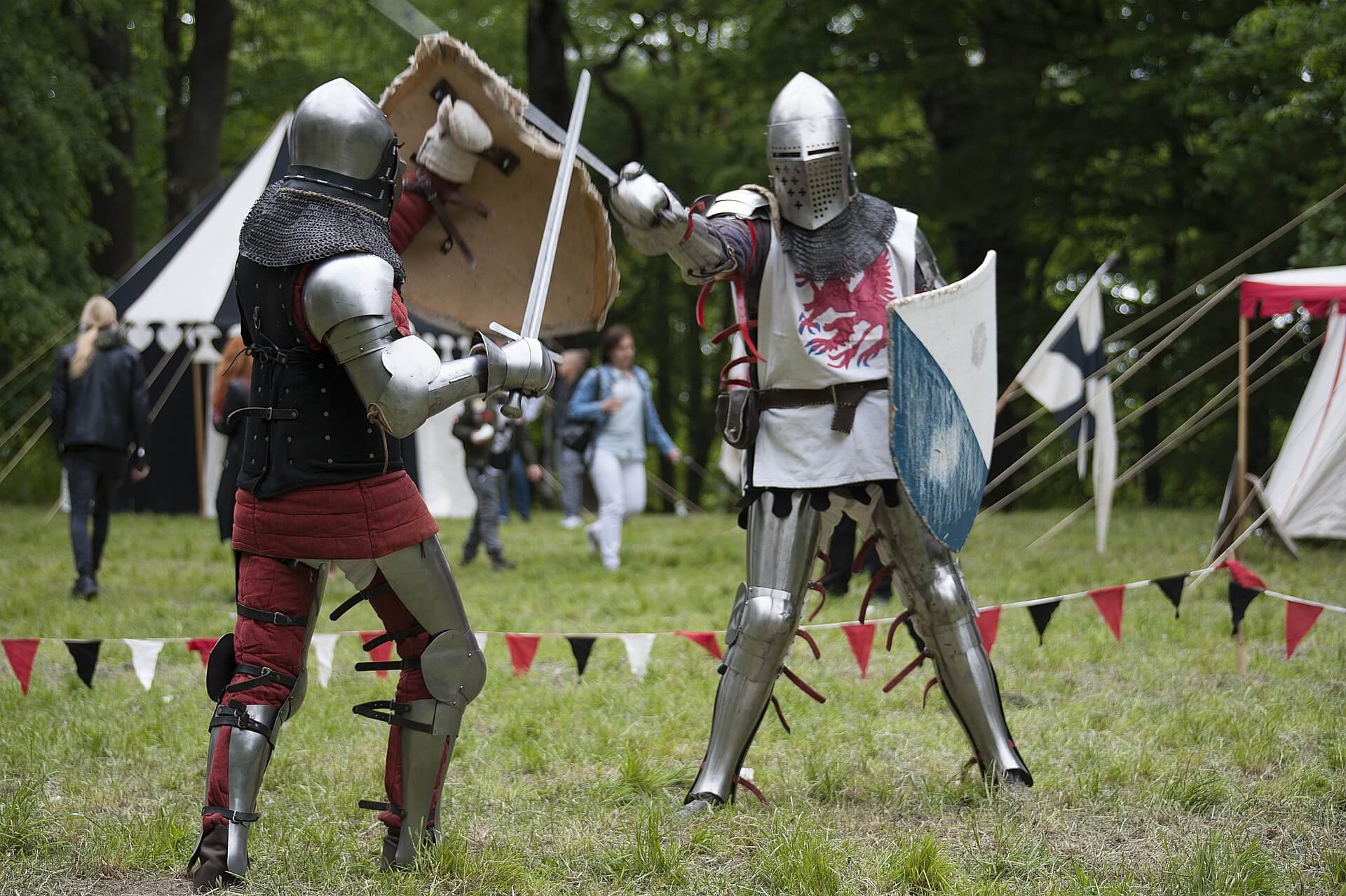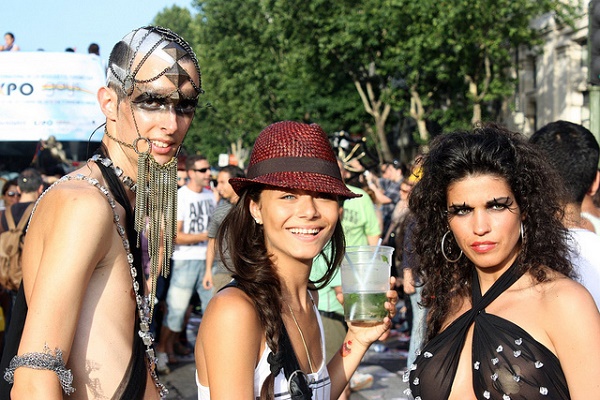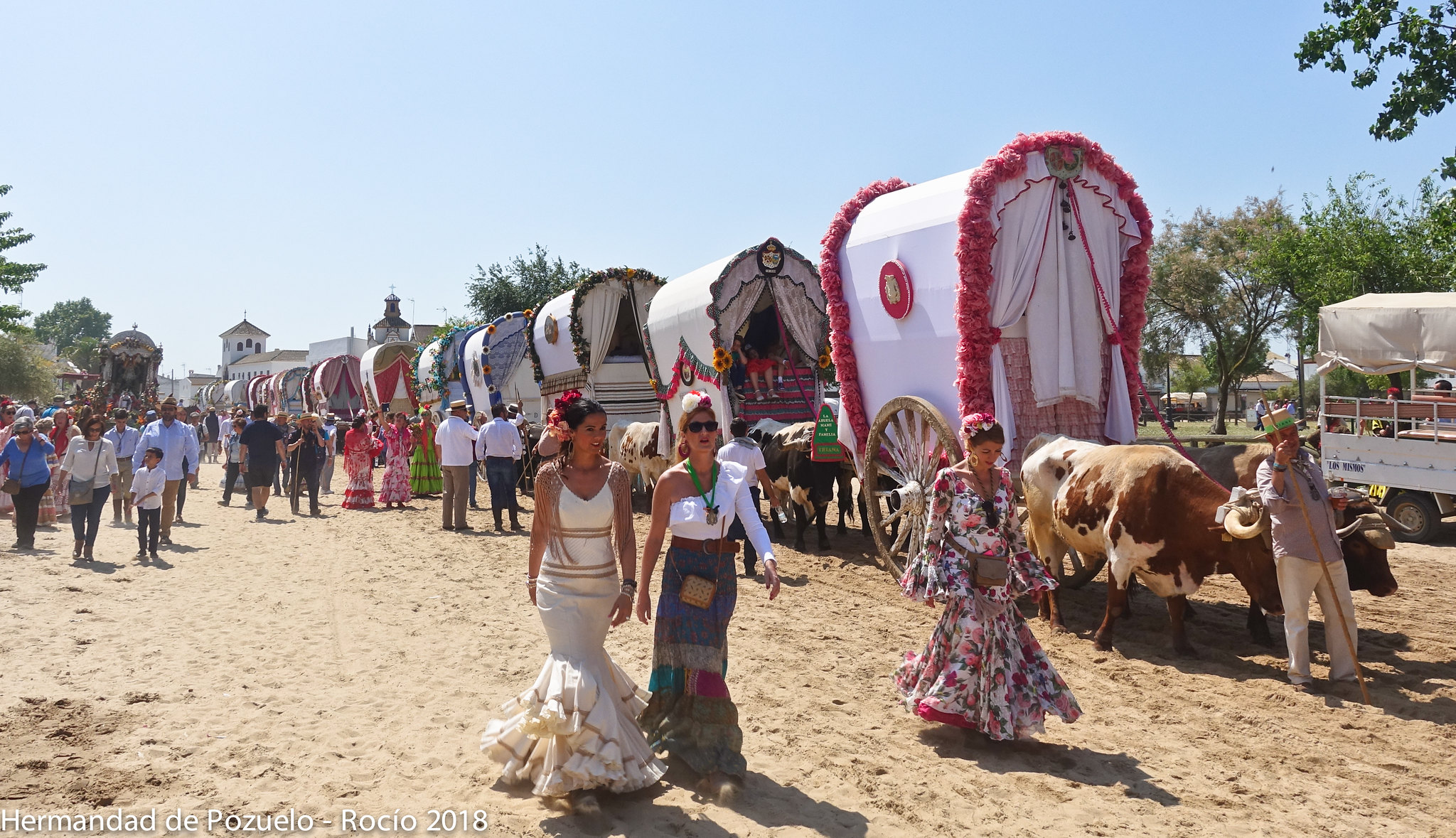Navarra is a region steeped in rich cultural heritage where history and tradition come alive through its vibrant annual fiestas. These celebrations offer visitors a unique insight into the local way of life which include world-famous bull runs, religious pilgrimages and lively food fairs. The annual calendar of festivals in Navarra is filled with with diverse cultural experiences. The world-famous San Fermín festival, with its adrenaline-fueled encierros, stands in stark contrast to the quiet reverence of the Javierada pilgrimage.

Festivals in Navarra
San Fermín (Running of the Bulls)
The most famous of Navarra’s festivals is San Fermín which takes place in Pamplona from 6th to 14th July each year. The festival honours Saint Fermín, the co-patron saint of Navarra. The highlight of San Fermín is the encierro, or the running of the bulls which takes place each morning at 8am. Six fighting bulls are released to run through the streets of Pamplona’s old quarter accompanied by runners dressed in traditional white clothing with red neckerchiefs. This tradition dates back to the 13th century when cattle herders would run ahead of bulls being led to market.
As well as the bull runs, San Fermín features numerous other events, including parades of gigantes y cabezudos (giant figures and big heads), religious processions, fireworks displays and traditional Basque sports competitions. The festival attracts hundreds of thousands of visitors from around the world who transform Pamplona into a hub of non-stop celebration for nine days.
Javierada (Castillo de Javier)
The Javierada is a pilgrimage which takes place twice each March, typically on the first and second weekends of the month. Pilgrims from across Navarra and beyond make their way to the Castle of Javier, birthplace of Saint Francis Xavier, one of the founders of the Jesuit order.

The tradition began in 1940 to commemorate the 400th anniversary of Saint Francis Xavier’s journey to the East. Today, thousands of people participate in the pilgrimage, walking up to 52km from Pamplona to Xavier. The journey typically takes around 12 hours, with many pilgrims starting their trek in the early hours of the morning.
Upon reaching the castle, participants attend an open-air mass and explore the birthplace of the saint. The Javierada is not only a religious event but also a cultural phenomenon which brings together people of all ages from all over the region.
Medieval Festival (Olite)
Recognized as an event of special tourist interest, a visit to the annual Olite Medieval Festival ranks amongst the top things to do in Navarra. The event transports visitors back to the glorious era when Olite served as the royal court of Navarra, offering a vivid glimpse into the region’s rich historical past.
The festival’s origins are rooted in commemorating a significant historical event – the marriage of Charles, Prince of Viana, to Agnes of Cleves, a Burgundian princess, which took place on September 30, 1439. The inaugural festival marked the 555th anniversary of this royal union.
Over a weekend, the entire town of Olite transforms into a medieval wonderland. Streets and squares are adorned with period decorations, creating an immersive atmosphere that reflects the grandeur of Navarre’s royal past. Visitors can witness and participate in various reenactments and activities that bring history to life.

The festival features grand processions led by actors portraying kings, princes, and princesses, accompanied by skilled performers such as jugglers, archers, and falconers. Throughout the town, one can encounter spontaneous medieval dance performances, adding to the festive ambiance.
A highlight of the event is the medieval market, boasting over 70 stalls offering period-appropriate goods and crafts. Attendees can also enjoy traditional games like chess and watch archery demonstrations. The festival’s success relies heavily on community involvement, with many local residents participating in the reenactments and activities.
Fiestas de Santa Ana (Tudela)
The Fiestas de Santa Ana take place in Tudela from 24th to 30th July each year. They honour Saint Anne, the patron saint of the city and showcases Tudela’s rich cultural heritage. The festival begins with the chupinazo, a rocket launch that signals the start of the celebrations. Throughout the week, the city comes alive with a diverse programme of events, including traditional dance performances, concerts, bullfights and religious processions. One of the highlights is the Revoltosa, a playful event where participants throw water at each other from balconies and windows, creating a joyful atmosphere in the streets.
The town of Tudela is renowned for its gastronomy, particularly its vegetables grown in the fertile Ebro valley. During the Fiestas de Santa Ana, local restaurants showcase these prized ingredients in traditional dishes. The festival coincides with the height of the vegetable season, offering visitors a chance to taste Tudela’s famous artichokes, asparagus and piquillo peppers.
Día de la Tostada (Arróniz)
Held on the last Sunday of February, the Día de la Tostada (Day of the Toast) in Arróniz is a gastronomic festival which celebrates one of Navarra’s most prized products: olive oil. The event has its roots in the region’s long history of olive cultivation and oil production. It is officially recognised as a Fiesta de Interés Turístico de Navarra.

During the festival, visitors can sample freshly made toast drizzled with new season’s extra virgin olive oil from the local cooperative. The oil is paired with various toppings, including garlic, salt and even sugar, allowing attendees to experience the full range of flavours.
The Día de la Tostada also features an olive oil competition, where producers from across Navarra showcase their best oils. Educational workshops, craft markets and traditional music performances round out the event, making it a comprehensive celebration of Navarra’s culinary heritage.
Fiesta del Olentzero
The Fiesta del Olentzero is celebrated on 24th December in many towns and villages across Navarra, particularly in areas with strong Basque cultural influences. Olentzero is a mythical figure in Basque tradition, often depicted as a coal miner who brings gifts to children on Christmas Eve.
The origins of Olentzero are tied to pagan winter solstice celebrations, which were later incorporated into Christian traditions. During the festival, people dress up as Olentzero, typically portrayed as a sturdy man with a black beard, wearing rural Basque clothing and carrying a sack of gifts.
Parades featuring Olentzero are common, with children singing traditional songs and collecting sweets. In some places, large Olentzero figures are created and displayed in town squares. The celebration also often includes bonfires, symbolic of the winter solstice traditions from which the festival originated.
Fiestas de San Fermín Txikito
Held in Pamplona in late September, the Fiestas de San Fermín Txikito (Little San Fermín) is a smaller-scale version of the famous July festivities. This event originated in the 19th century when local shopkeepers and residents of the San Nicolás neighbourhood sought to extend the summer season with another celebration.

Unlike its larger counterpart, San Fermín Txikito does not include bull runs. Instead, it focuses on cultural and traditional aspects of Navarrese life. The festival features parades, folk dancing, concerts and sporting events such as pelota (Basque handball) tournaments. One of the highlights is the Giants Parade, where large puppet figures representing kings and queens from different cultures dance through the streets to the rhythm of traditional music.
Jornada de Exaltación del Pimiento del Piquillo (Lodosa)
Taking place on the first weekend of October, this local fiesta celebrates Lodosa’s famous piquillo peppers. These small, triangular red peppers have been cultivated in the area for centuries and hold Protected Designation of Origin status.
The festival began in the 1980s as a way to promote this local delicacy and has since grown into a major gastronomic event. During the celebration, visitors can taste piquillo peppers prepared in various ways, from simple roasted peppers to elaborate dishes incorporating them.
A highlight of the festival is the piquillo pepper eating contest, where participants compete to eat as many peppers as possible within a set time. The event also includes cooking demonstrations, pepper roasting exhibitions and a market where local producers sell their peppers and related products. https://turismotierraestella.com/evento/exaltacion-del-piquillo-de-lodosa/
Fiesta de la Vendimia (Olite)
The Fiesta de la Vendimia in Olite is a celebration of Navarra’s grape harvest. Typically held in late August or early September, this festival takes place in the historic town of Olite, renowned for its medieval castle and thriving wine industry. The event marks the beginning of the grape harvest season and showcases the region’s rich winemaking heritage.

During the festival, visitors can witness and participate in various activities that highlight local traditions. A centerpiece of the celebration is the grape stomping ceremony, accompanied by wine tasting sessions that showcase the finest local vintages. The streets come alive with parades featuring participants in traditional costumes whilst music and dance performances add to the festive atmosphere.
The Fiesta de la Vendimia not only celebrates the local wine industry but also offers a glimpse into the broader culture of Navarra. Local wineries often open their doors for tours and special tastings, while food stalls serve up regional specialties. Craft markets selling local products provide an opportunity for visitors to take home a piece of Navarra’s artisanal heritage.
Carnaval de Lantz
Held in the small village of Lantz during the days leading up to Lent, this is one of the most unique and ancient festivals in Navarra. The event has roots stretching back to pre-Christian times and features a cast of peculiar characters and rituals that have been preserved through generations.
The main character of the carnival is Miel Otxin, a straw effigy representing all the evils and misfortunes of the past year. Throughout the festival, Miel Otxin is paraded through the village before being put on trial, sentenced and finally burned in the village square on Shrove Tuesday.
Other notable figures include the Ziripot, a man wrapped in straw and rags who stumbles through the streets and the Zaldikos, horse-like figures who chase and whip onlookers. The Carnaval de Lantz offers a fascinating glimpse into Navarra’s pagan past and the way these traditions have been integrated into the Christian calendar.
El Misterio de Obanos
The Mystery of Obanos is a unique theatrical performance and cultural event held outdoors over several evenings in late July or early August. The performance dramatizes a medieval legend centreed around Felicia, a noblewoman from Aquitaine and her brother Guillén. According to the story, Felicia abandoned her privileged life to become a pilgrim on the Camino de Santiago. Her brother, sent to bring her home, eventually follows in her spiritual footsteps after witnessing her devotion.
What makes the Mystery of Obanos particularly special is its format and community involvement. The play is performed entirely by local residents, with hundreds of volunteers participating as actors, musicians and support staff. The entire town becomes a stage, with different scenes unfolding in various locations, including the town square, streets and the church.
The performance combines elements of traditional theatre, religious pageantry and historical reenactment. It features period costumes, live music and elaborate set designs which transform Obanos into a medieval setting. The dialogue is delivered in archaic Spanish, adding to the historical atmosphere.
Día de la Almadía (Burgui)
This traditional festival has been recognised as a fiesta of national interest which takes place in late April or early May. The event takes place in the village of Burgui and pays homage to the ‘almadieros’, the skilled raftsmen who once transported timber down the rivers of Navarra. This dangerous profession, which dates back to the Middle Ages, played a crucial role in the region’s economy until the mid-20th century. During the festival, traditional log rafts (almadías) are constructed and piloted down the Esca River, recreating the perilous journeys of the past.
The event attracts thousands of spectators who line the riverbanks to watch the spectacle. In addition to the raft rides, the festival features demonstrations of traditional woodworking techniques, local craft markets and performances of folk music and dance. The Fiesta de la Almadía serves as both a tribute to Navarra’s logging heritage and a means of preserving this unique aspect of the region’s cultural identity.
Día de las Migas (Ujué)
Held on the last Sunday of September, the Día de las Migas is a gastronomic festival centred around migas, a traditional shepherds’ dish made from breadcrumbs, garlic and olive oil. The event takes place in the beautiful medieval hilltop village of Ujué, known for its impressive fortress-church and panoramic views of the surrounding countryside.
The festival began in the 1970s as a way to attract visitors to the village and showcase local culinary traditions. Throughout the day, large pans of migas are prepared in the village square, with visitors invited to sample this rustic dish alongside other regional specialities such as roasted peppers and local wines. The Día de las Migas also features craft demonstrations and folk music performances.
Fiesta de San Vicente (Los Arcos)
The Fiesta de San Vicente in Los Arcos is a traditional celebration honouring Saint Vincent, the patron saint of winemakers, held annually on January 22nd in the small Navarran town of Los Arcos. The day begins with a solemn religious procession through the town’s streets, where a statue of San Vicente is carried by locals dressed in traditional attire. Following the procession, a special mass is held in the Church of Santa María, a beautiful Gothic-Renaissance building that serves as the focal point of the celebration.
After the religious ceremonies, the festival takes on a more festive atmosphere. One of the most distinctive features of this celebration is the distribution of bread, wine and sardines to all attendees. This tradition, known as ‘la caridad,’ symbolizes sharing and community spirit, core values of the local culture. Throughout the day, the town comes alive with music, dance and various cultural activities. Local wine producers often participate, offering tastings of their products and showcasing the region’s viticultural expertise.
El Tributo de las Tres Vacas (Roncal)
The Tributo de las Tres Vacas (Tribute of the Three Cows) is an ancient ceremony that takes place annually on 13th July in the Ernaz pass of the Pyrenees, on the border between Spain and France. This event, which dates back to 1375, commemorates a peace agreement between the valleys of Roncal (in Navarra) and Baretous (in France) following years of conflict over grazing rights.
According to the terms of the agreement, representatives from the Baretous valley must present three cows to the Roncal valley as a symbolic payment for the use of Navarrese pastures. The ceremony begins with the mayors of both valleys placing their hands on a boundary stone and declaring ‘Pax Avant’ (Peace from now on) three times.
The Tributo de las Tres Vacas is not only one of the oldest annually recurring treaties in Europe but also a testament to the enduring connections between border communities. The event attracts spectators from both sides of the border and serves as a reminder of the shared history and traditions of the Pyrenean region.
La Bajada del Ángel (Tudela)
The city of Tudela hosts a remarkable Easter tradition known as ‘The Angel’s Descent’ which is recognized as an event of national and regional tourist interest. It takes place on Easter Sunday and depicts the angel Gabriel’s appearance to the Virgin Mary, announcing Jesus’ resurrection.
The roots of this tradition stretch back to 1264, when Pope Urban IV issued a papal bull to counter heretical movements. This led to the formation of many confraternities dedicated to the worship of the Blessed Sacrament. Tudela’s own Brotherhood of the Blessed Sacrament, established shortly after, played a crucial role in developing this unique celebration.
Initially, the ceremony featured six children dressed as angels accompanying a procession. However, in 1663, it evolved into its current form, featuring a single ‘flying’ angel. This change proved so popular that it attracted numerous new members to the brotherhood.
The event unfolds in Tudela’s main square, Plaza de los Fueros, early on Easter Sunday. A procession from the Cathedral, carrying the Blessed Sacrament and a statue of the Virgin Mary, arrives at the square around 9:10 AM. The square is lined with spectators, local authorities, and church dignitaries.
The highlight of the ceremony occurs when a young child, dressed as an angel, descends on a rope mechanism from a ‘heaven’ structure on one building to another across the square. As the angel descends, they make the sign of the cross three times and scatter confetti. Upon reaching the statue of the Virgin Mary, the angel proclaims, ‘Rejoice, Mary, for your Son has risen!’ The angel then removes the Virgin’s black veil, symbolizing the end of mourning and the joy of resurrection.



